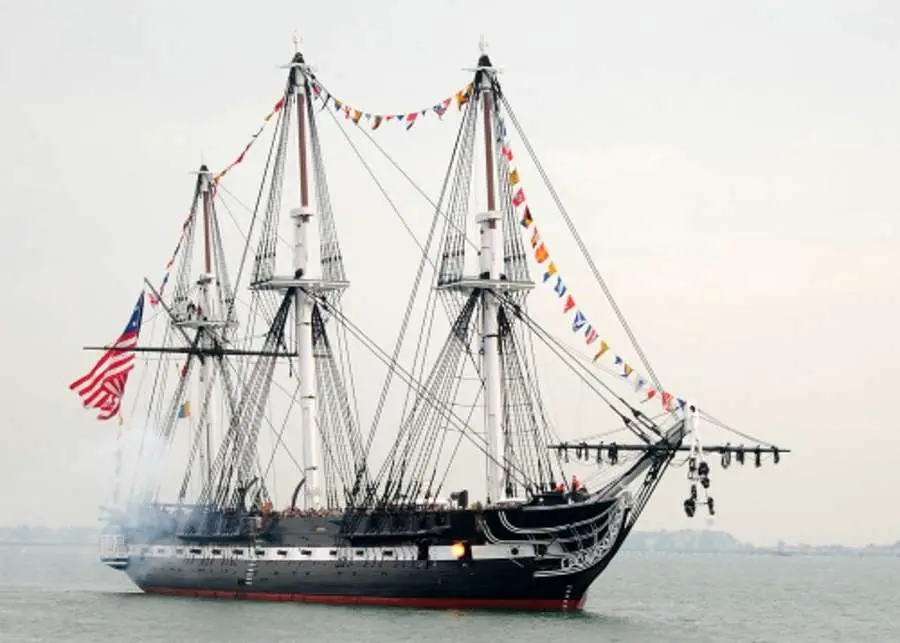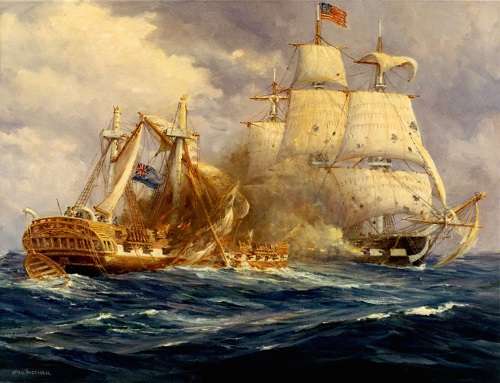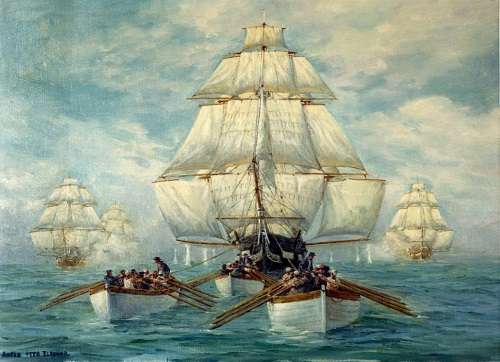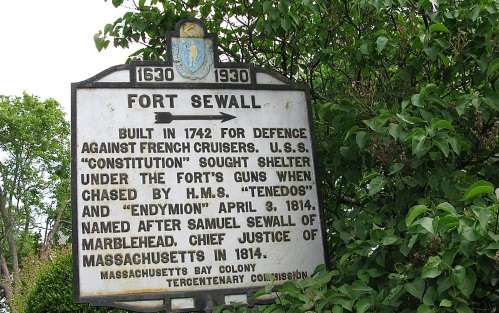On April 3, 1814, the United States almost lost its most famous ship: the U.S.S. Constitution. But thanks to the quick thinking of some sea-savvy citizens of Marblehead, Mass., the ship was saved from a watery grave during the War of 1812.
“Old Ironsides” got her nickname when cannonballs seemed to bounce off her sides during her victorious battle with the HMS Guerriere in 1812. Paul Revere provided the copper sheathing for the sides of the frigate, built in 1797 of pine and oak.
But on that spring day in 1814, she was limping north off the coast of Cape Ann in need of both supplies and repairs. She headed to the shipyard in Portsmouth, N.H., after spending months chasing hostile ships in the Caribbean. Two British warships, the HMS Judon and the HMS Tenedo, caught sight of her. The British frigates outgunned Constitution, and the wind was in their favor. They immediately gave chase.
The Constitution Flees
With his ship hopelessly outmatched and his crew in mortal danger, Capt. Charles Stewart decided to change direction and head south for the nearest safe port. He ordered Constitution’s crew to throw their water and rum supplies overboard because he hoped to lighten the ship and escape.
Stewart felt his best chance was to find a port where local artillery could deter the British frigates. He initially thought of Salem, Mass., but nobody on board had piloted a ship of Constitution’s size into Salem Harbor.
But many men on board hailed from Marblehead, and they knew well how to navigate the harbor of that famous fishing town. They also knew that at the mouth of Marblehead’s harbor, on a place called Gale’s Head, stood Fort Sewall, an earthen fort manned by a US infantry regiment. Fort Sewall’s guns could protect the Constitution— if the ship could make it there in time.
A History of Defense
Fort Sewall was built in 1644 to protect Marblehead from the Dutch, the French and pirates, often seen in Massachusetts waters. Initially, the colony’s General Court approved funds for ammunition, simple earthworks and two cannons. In 1742, the fort expanded as conflict between the English and French grew. But in the years between the French and Indian War and the American Revolution, the fort fell into disrepair.
In 1775, the HMS Lively and the HMS Nautilus set their sights on Marblehead. Desperate townspeople, lacking able-bodied men (many at war or decimated by smallpox), called upon old and young alike to man the fort. They lacked ammunition, but bravely pointed their cannons toward the invaders. They spent one of their few rounds to fire what they hoped the British would see as a warning shot. Fortunately for the plucky “Headers,” the ruse worked, and the British vessels moved on.
Originally named Gale’s Head after the land it stood on, in 1814 the fort was christened Fort Sewall to honor Massachusetts Supreme Court Justice Samuel Sewall, a Marblehead native.
Sailing Into the Guns
On that fateful April day in 1814, Captain Stewart asked Marbleheader Samuel Harris Green, still recovering from a leg injury, to pilot the ship around the treacherous rocks scattered near the entrance to Marblehead Harbor. Green limped his way to the deck to command the helmsmen to steer toward the safety of Fort Sewall’s guns.
Meanwhile, Fort Sewall’s gunners, members of the 40th Regiment led by Capt. John Bailey, saw an alarming scene: three British warships headed for Marblehead. They mistook the Constitution for a British vessel because one of the Constitution’s sails billowed in front of the U.S. flag. The Marbleheaders could not see it. The British ships tailed Constitution so closely that the townspeople assumed the three ships belonged together. The soldiers aimed their guns at their country’s most famous warship.
Thankfully, Captain Stewart realized what was happening. He ordered one of his sailors to climb up the rigging as fast as he could to pull Old Glory out from behind the sail that obscured it. When they saw the American flag, the men of the 40th Regiment cheered. They then trained the fort’s cannons on the Tenedo and the Judon.
The British warships retreated. Constitution went on not only to endure through the remainder of the war but also to become a national treasure. She is the oldest military ship in the world that still sails. She recently underwent a major two-year restoration, and set sail again in 2018.
Fort Sewall, Marblehead, and the USS Constitution: Legacy
Fort Sewall and Marblehead have been honored throughout the centuries for saving the Constitution. In 1931, on tour to raise money for her preservation, Constitution visited Marblehead Harbor. The ship visited Marblehead again in 1997 on her 200th anniversary as an official “thank you” to the town.
In 2017, the Town of Marblehead received an eight-foot section of Constitution’s original white-oak bowsprit (a spar that extends out the ship’s bow). The section given to Marblehead weighs 1,500 pounds. The bowsprit is on display in Abbot Hall, the landmark building housing much of Marblehead’s town government.
In 1922, the federal government gave Fort Sewall and the land it sat on back to Marblehead. While repairs and updates have been made periodically throughout the years, the fort needs major restoration. At their 2019 Town Meeting, the citizens of Marblehead voted to approve more than $700,000 to help restore and improve the fort as its marks its 375th anniversary. The restorations will include reproduction cannons modeled after those that stood on the site—and saved the USS Constitution—during the War of 1812.
The author of this story, Rebecca Del Giudice, is a writer and editor who lives in Massachusetts.
Sources
“A Marblehead Escape.” USS Constitution Museum.
April 2, 2014.
“Fort Sewall.” Essex National Heritage Area website.
https://essexheritage.org/attractions/fort-sewall
Last accessed 05/19/2019.
“Historic Places: A Walk Through Historic Marblehead.” Marblehead Historical Commission website.
Last accessed 5/19/2019.
Bode, Kelsey. “Committee Launches $1.1M Campaign to Restore Fort Sewall.” The Salem News.
January 13, 2019.
Dowd, William J. “Marblehead Town Meeting Backs $750k for Fort Sewall Project.” Wicked Local Marblehead.
Last updated May 8, 2019.
Peterson, Pam Matthias. Marblehead: Myths, Legends, and Lore: From Storied Past to Modern Mystery. History Press: Charleston, S.C., 2007.
Stevens, Chris. “A Piece of Old Ironsides at Home in Marblehead.” Wicked Local Marblehead.
Last updated Sept. 17, 2018.
Images: Fort Sewall marker By Elizabeth B. Thomsen – Own work, CC BY-SA 4.0, https://commons.wikimedia.org/w/index.php?curid=76624036. This story was updated in 2021.







1 comment
[…] Royal Navy ships took to cruising in squadrons to avoid being outgunned by 44-gun frigates like Constitution and their excellent […]
Comments are closed.